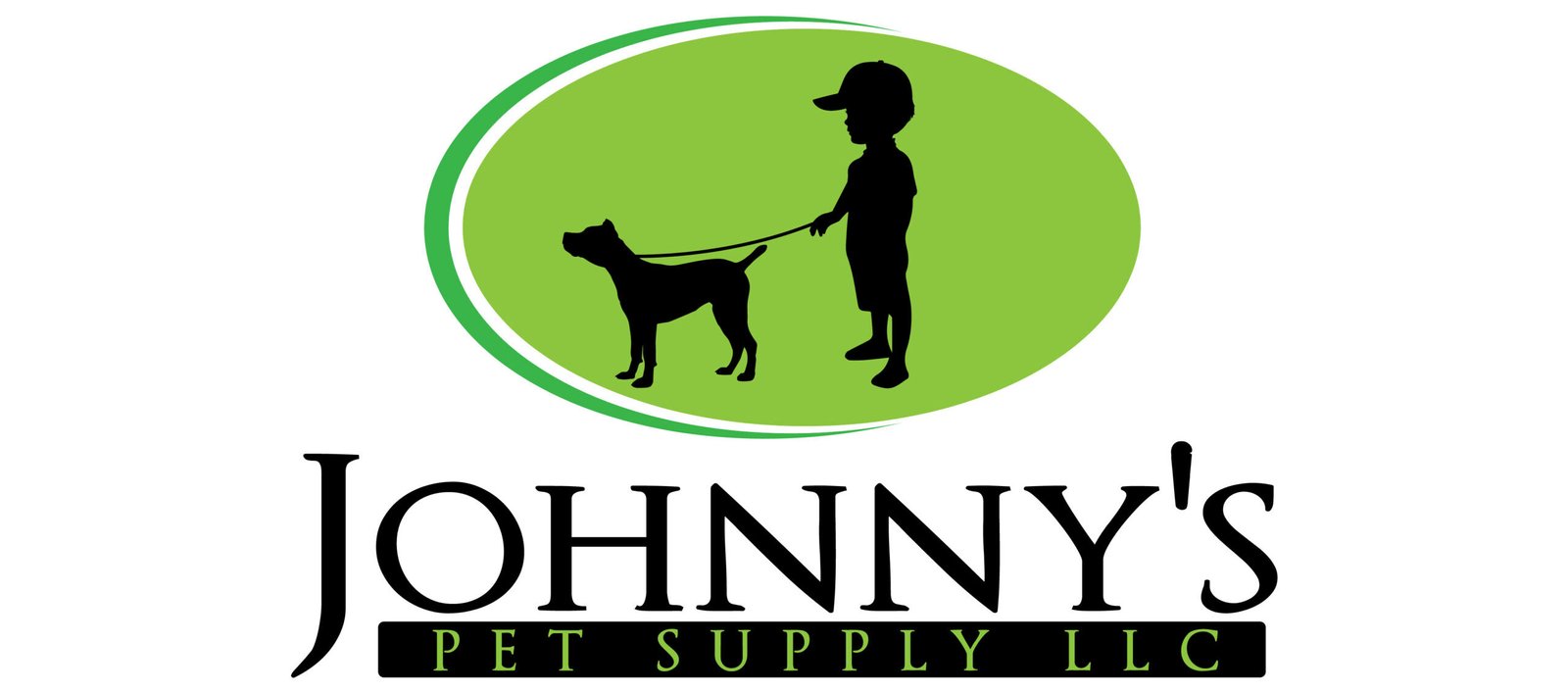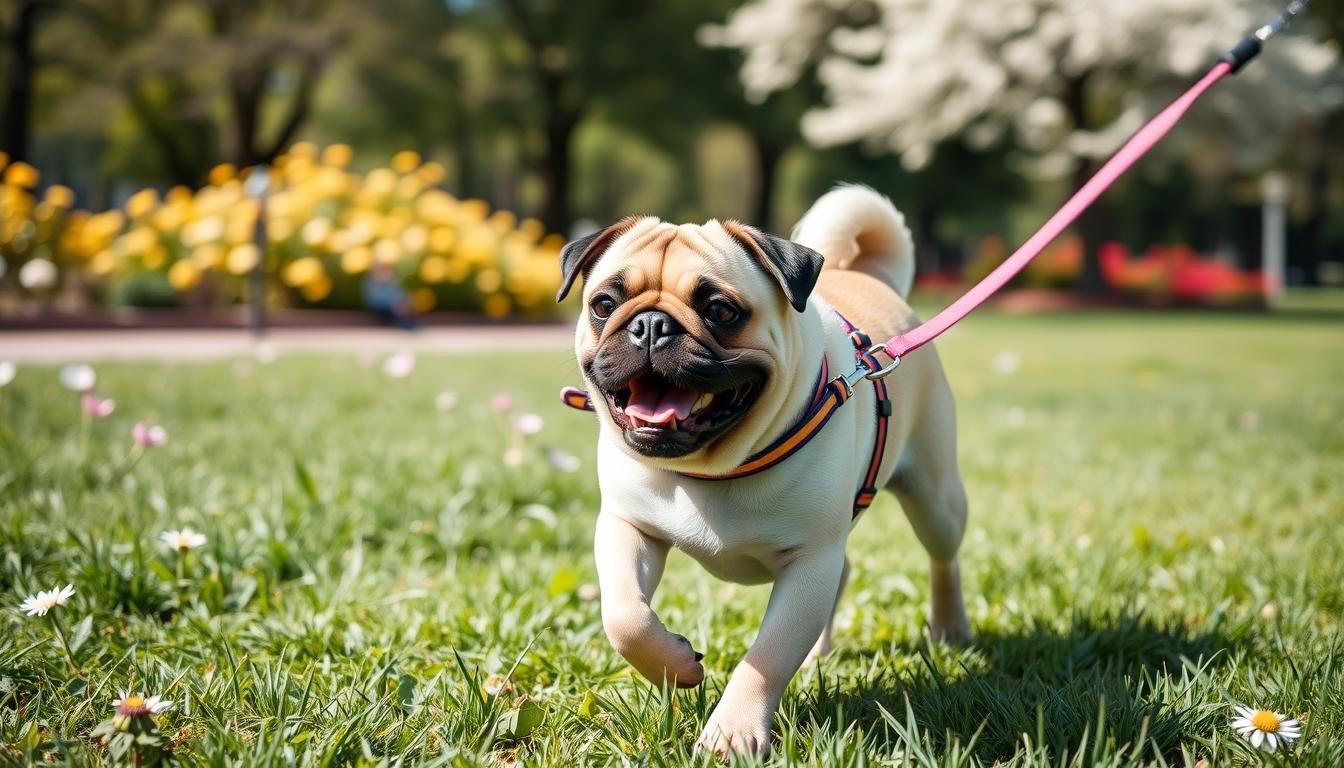How to avoid accidents during leash training with Pugs
Did you know male Pugs urinate up to six times before their bladder is empty? This fact shows why leash training is key for their safety and your peace of mind. By understanding your Pug’s personality, choosing the right gear, and using positive methods, you can avoid accidents.
This guide will help you and your Pug have fun and stress-free walks. You’ll learn how to handle common issues like pulling and biting. Remember, Pugs are social, stubborn, and curious. So, it’s important to tailor your training to their needs for the best results.
Understanding Your Pug’s Personality
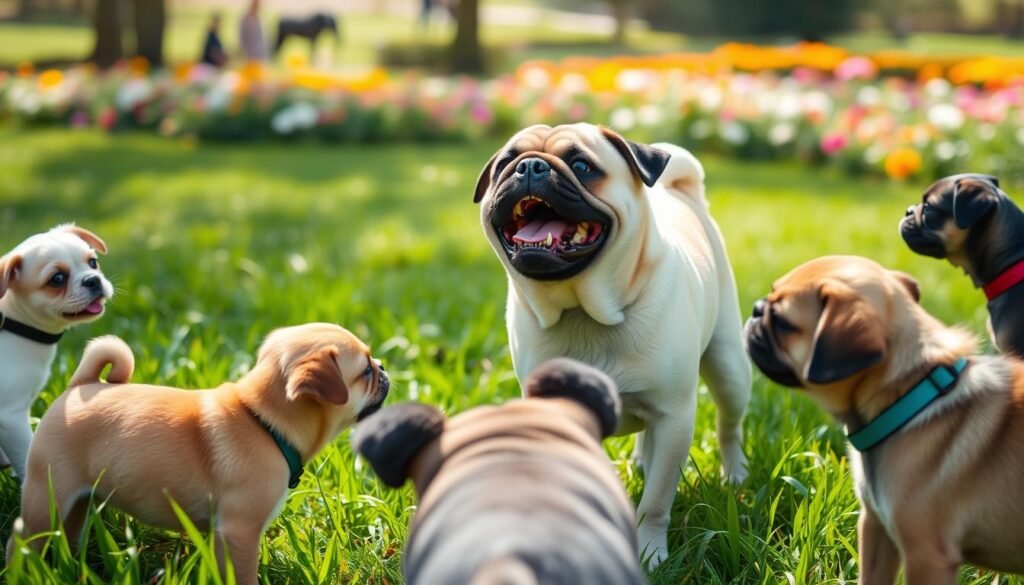
Pugs are wonderful friends known for being friendly and fun. To train them well on a leash, knowing their personality is key. They love people and other animals, making socialization important before walks.
Pugs can also be a bit stubborn. This makes training them patient and consistent. Their curiosity might make them wander, so a strong leash is vital.
“Pugs are intelligent and eager to please, but can be stubborn at times. Proper socialization and consistent training are key to overcoming their challenges.”
Knowing the Pug breed behavior, Pug temperament, and Pug personality traits helps with leash training. By using their sociability, addressing stubbornness, and managing curiosity, you can raise a well-behaved Pug.
Choosing the Right Leash and Collar
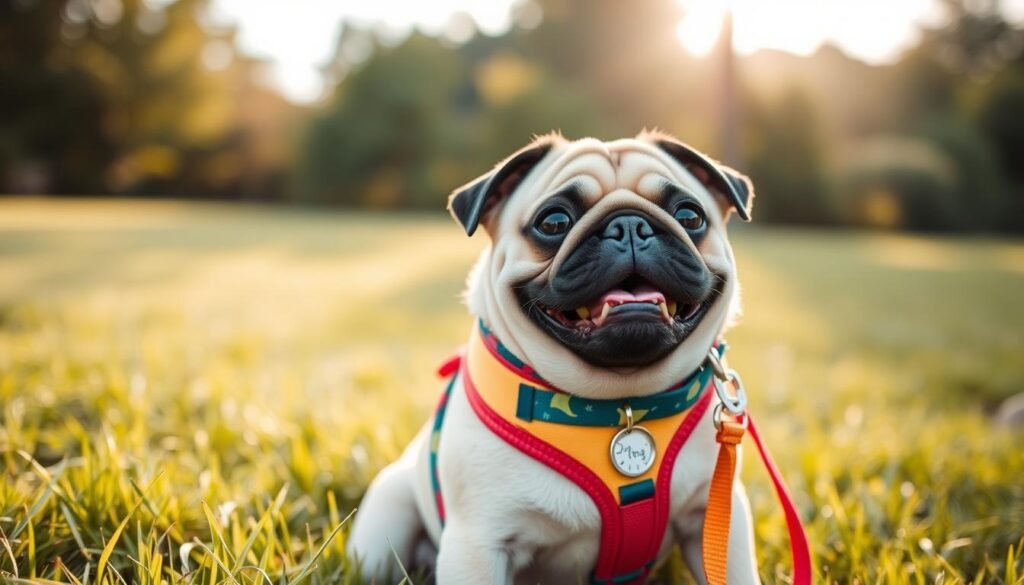
Choosing the right leash and collar is key for safe and effective training of Pugs. Their short necks and delicate tracheas make a Pug harness a better choice than a Pug collar.
Pug Collar Options
For a Pug collar, pick one that’s comfy and fits well. It should not put too much pressure on their neck. Cotton collars are a top choice, with many owners giving them a perfect score.
The collar should be a bit bigger than your Pug’s neck. This way, you can fit two fingers under it comfortably.
Pug Harness Types
A Pug harness is usually the best option. It spreads the pressure on the chest area evenly. This prevents any restriction in movement.
Nylon harnesses are durable and popular. However, stretchy harnesses might be better for puppies but not for adult Pugs. Look for harnesses with snap buckles for easier use.
Leash Length for Pugs
The best leash length for Pugs is a regular straight leash, 4-6 feet long. This length gives you control while still letting your Pug explore.
When picking a leash and collar or harness for your Pug, focus on durability and comfort. Features like reflective strips are also good for evening walks. Make sure your Pug is comfortable and properly fitted.
Building a Routine
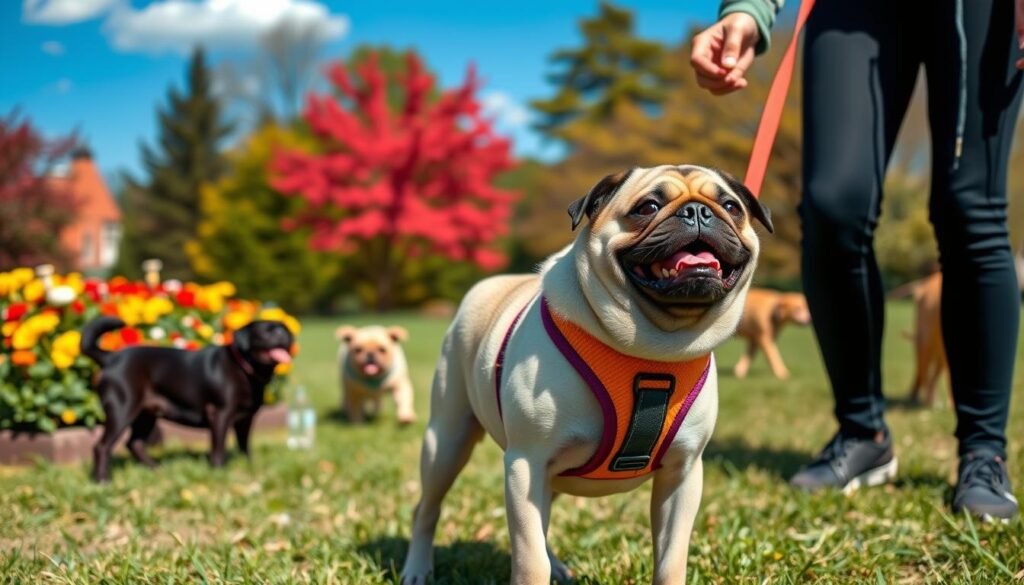
Creating a consistent routine is crucial for leash training your Pug. Set specific times for walks each day. This helps your Pug see walking on a leash as a positive thing.
Designate Specific Times
Choose times like morning, afternoon, and evening for walks. This makes your Pug know when it’s time to go out. It also helps stick to the Pug leash training routine.
Short, Frequent Sessions
Begin with 10-15 minute walks and slowly add more time. Short, regular walks keep your Pug interested and avoid exhaustion.
Repetition Reinforces Positive Behavior
Being regular with leash training makes good behavior stick. Your Pug will learn that walking calmly is good. This makes walks fun for both you and your Pug.
Following a routine helps build a strong leash training foundation for your Pug. Remember, patience and consistency are essential. They help your Pug enjoy walking on a leash.
Positive Reinforcement Techniques
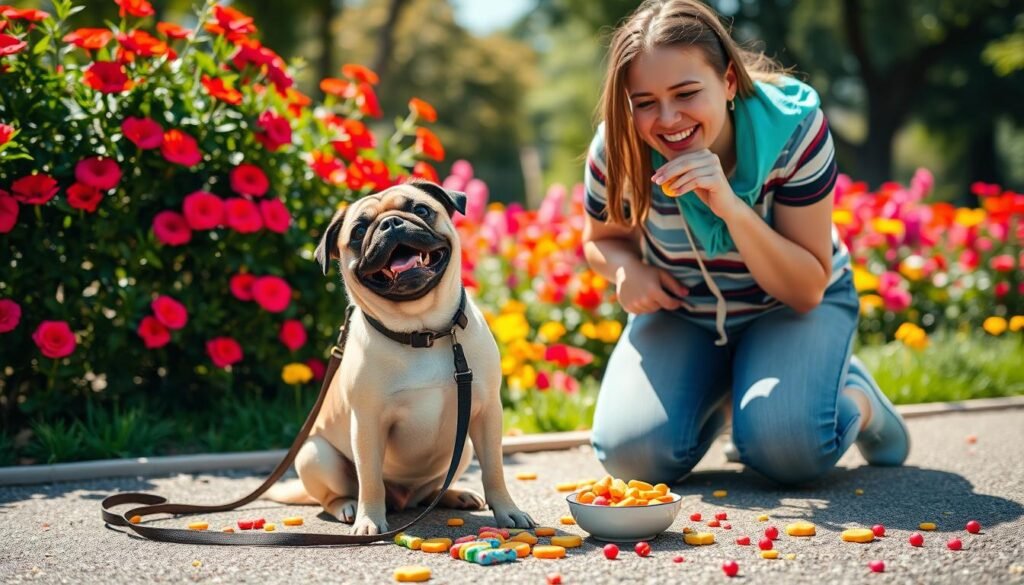
Positive reinforcement is a great way to leash train your Pug. Rewarding them with treats and praise for good behavior helps them learn. This method is more effective than punishment, as it makes them want to do the right thing.
Clicker training is also very effective for Pugs. It uses a small clicker to mark good behavior, followed by a treat. This makes it clear to your Pug what actions get rewards, making learning fun and efficient.
To make these methods work, keep training consistent. Short, fun sessions with rewards for good behavior are key. This helps your Pug learn quickly and happily.
“Positive reinforcement is a game-changer in leash training for Pugs. It makes the process fun and rewarding for both the dog and the owner.”
Using these positive reinforcement techniques in your leash training will make it enjoyable for your Pug. This leads to a well-trained and confident Pug.
How to Avoid Accidents During Leash Training with Pugs
Pug leash training is key for your pup’s safety and yours. Knowing your Pug’s personality, picking the right gear, and using positive methods can lower accident risks. Here are some tips to keep your Pug safe and training sessions easy.
Pug walking precautions are vital, as these dogs can get distracted or stray. Choose a comfy, fitting collar or harness for safety. A no-pull harness, like Rabbitgoo, can stop accidents from sudden pulls.
Creating a consistent Pug leash training routine is crucial. Set walk times and start with short, frequent walks. This repetition will help your Pug learn good walking habits. Using treat-based rewards can make your Pug more responsive during training.
- Always stay alert and know your surroundings to avoid Pug leash training safety issues.
- Check for any health or safety concerns that might affect your Pug’s leash walking.
- Use Pug leash training tips from trusted sources like SpiritDog or the K9 Training Institute’s “Masterclass” program.
By following these tips and focusing on responsible Pug ownership, you can have a safe and effective leash training experience with your Pug.
Challenges Faced in Leash Training for Pugs
Training Pugs on a leash can be tough. They are smart and curious, which can make walks hard if not managed right.
Pug Pulling Behavior
Pugs often pull on the leash, which is risky for both the dog and the owner. Use a no-pull harness to help. It spreads the pressure across the dog’s chest, not just the neck. Also, teach them to walk calmly by you.
Pug Lunging at Distractions
Pugs get excited by new sights and sounds. To stop this, use treats to keep their focus. Start by exposing them to new places a little at a time.
Pug Refusing to Walk
Some Pugs won’t walk because of fear, anxiety, or stubbornness. Be patient and use positive rewards. Carry treats to keep them moving.
Pug Leash Biting
Pugs might bite the leash when they’re frustrated or need more activity. Give them a chew toy or a toy to play with during walks.
Pug Overexcitement During Training
Pugs can get too excited during training. Shorten training sessions and use treats to keep them interested.
Knowing these common challenges and using the right training methods can make your Pug a great walking buddy.
The Need for Consistency in Leash Training for Pugs
Consistency is key for leash training Pugs. They love a structured routine and positive feedback. This builds trust and stops them from seeing the leash as bad.
Don’t use retractable leashes, as they can make Pugs pull more. These leashes give too much freedom and can make pulling seem good. Use a regular leash that’s 4-6 feet long. It gives the right amount of control and freedom.
Socializing Pugs is also vital. Their friendly nature can sometimes make them scared of new things. Early exposure to positive experiences helps them feel confident and less scared during walks.
It’s also crucial to watch your Pug’s body language and energy. Adjust your training to keep it positive. This way, they’ll enjoy the walks more.
“Consistency is the key to successful leash training for Pugs. By establishing a structured routine and using positive reinforcement, you can help your Pug develop a healthy and enjoyable relationship with the leash.”
Avoiding common mistakes helps too. Don’t skip warm-up exercises or use punishment. Pugs are smart and want to please. With patience and consistency, they’ll become great walking buddies.
Health and Safety Considerations
When training your Pug on a leash, remember their special health needs. Pugs, being brachycephalic, can face breathing problems. Use a harness instead of a collar to avoid neck strain and breathing issues.
It’s also important to watch for signs of overheating, especially in warm weather. Look for excessive panting or lethargy. Make sure to give your Pug plenty of water breaks. Always check their paws after walks for injuries or foreign objects.
For the best care, talk to your vet about leash training. They can offer advice tailored to your Pug’s needs. This ensures a safe and positive training experience for both you and your pet.
